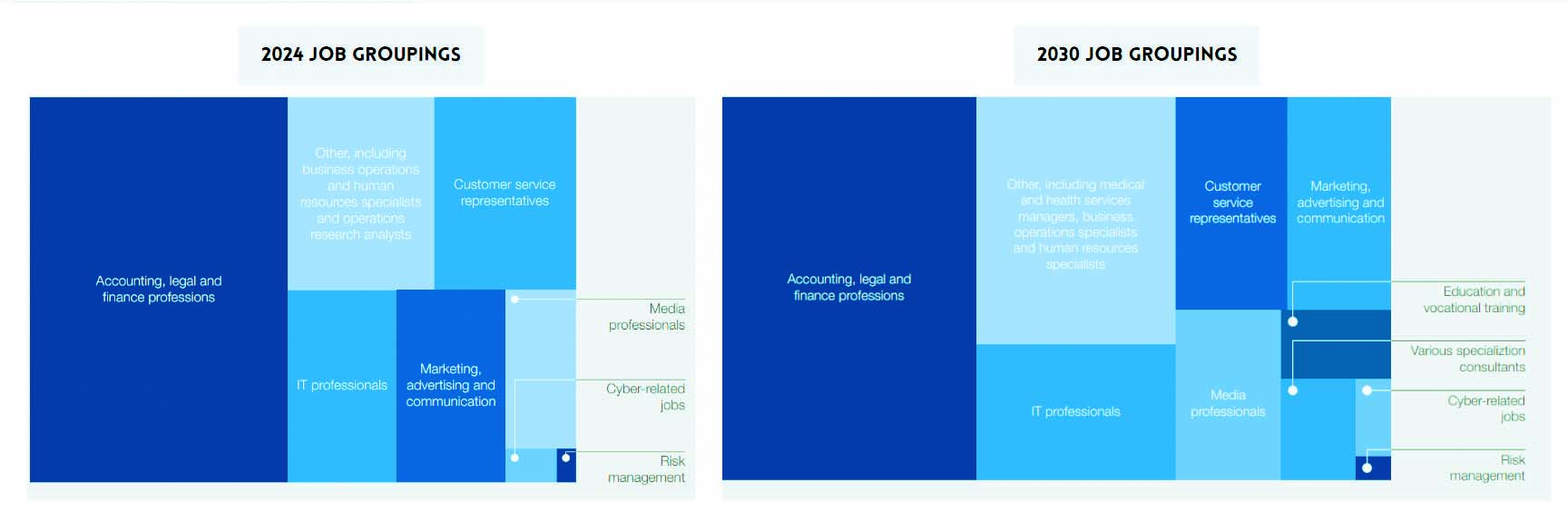
The Future of Jobs Report 2023 identifies three key factors set to transform businesses in the next five years: technology development and adoption, the green transition, and macroeconomic conditions.
The report anticipates a significant shift in jobs, with approximately a quarter of current roles changing, either through creation or displacement. Growth is expected in technology-enabled and green jobs, while roles susceptible to automation are predicted to decline.
The evolving landscape necessitates workers to transition between their current skills and future demands. The COVID-19 pandemic expedited the adoption of digital technologies in the workplace, fostering remote, hybrid, and new work practices.
Collaborative technologies that integrate workforce capabilities can identify opportunities by aligning project skill requirements with the development goals of employees globally. This facilitates organizations in enhancing diversity of thought by bringing together individuals from diverse cultures and backgrounds.
Metaverse technologies are giving rise to new platforms and tools that facilitate virtual conferences, making scarce and highly specialised knowledge accessible on a global scale without the necessity for physical travel.
Decentralised Autonomous Organisation (DAO) solutions are recognised as a technology capable of influencing governance, skills, recruitment, and compensation management. They establish transparent, collectively owned organisations governed by blockchain, fostering shared missions across various sectors, including investments, grants, art, media, and social impact.
Generative AI is poised to persistently alter the composition of jobs, leading to significant augmentation for certain occupations and functions.
In evaluating the feasibility of remote task performance, the research analyses the impact of widely adopted supporting technologies on the task’s requirements. For instance:
Communication tools, such as video conferencing and messaging platforms, enhance collaboration and connectivity for remote teams.
Cloud-based solutions provide easy access to shared documents, promoting collaboration and access to real-time information from any internet-connected location.
Data collection and analysis tools facilitate seamless collaboration across distances, enabling remote teams to work on data-related tasks efficiently.
Programming languages and tools empower individuals to code and troubleshoot remotely.
To determine the global count of these jobs, they were categorized into the 43 International Standard Classification of Occupations (ISCO) sub-major groups. The International Labour Organisation (ILO) offers global data at this level.
Applying these proportions to the International Labour Organisation (ILO) global data, the total number of these jobs in 2024 was estimated. Presently, approximately 73 million individuals are engaged in potentially digital and global jobs, constituting a portion of the ILO’s total formal global workforce, which stands at 820 million according to occupation employment statistics.
Within this segment, accounting, legal, and finance professionals account for nearly 43% of the jobs, while customer service representatives, along with marketing, advertising, and communication professionals, as well as IT professionals, each contribute around 10% to the total jobs.
By 2030, the size and composition of these jobs will be influenced by three main factors: the anticipated growth in the working-age population, the inclusion of new jobs in the potential digital and global category, and the growth or decline of certain roles driven by technological, sustainability, and economic trends.
These factors are projected to impact the number of these jobs, leading to an estimated total of around 92 million in 2030, reflecting a growth of approximately 25%. More than half of the growth in the global digital workforce, totalling 15 million, is attributed to new global digital jobs.
The majority of this growth stems from high-wage jobs (eight million), including roles like telecommunications managers and financial managers, while medium-wage jobs such as editors, writers, and authors contribute seven million.
Despite the overall positive job outlook, there is anticipated job churn in potentially digital global jobs, resulting in a slight net decrease of under 1%. This is due to the increase of growing jobs by just under 7 million and the decrease of declining jobs by just over 7 million. The shifting composition of these jobs, influenced by expected job growth and decline, is expected to tilt the balance towards higher-wage jobs. More precisely, there is an anticipated net growth of 14 million higher-wage jobs, encompassing roles like software developers, information security analysts, and financial risk specialists. Conversely, the majority of the net decline in employment, totalling a decrease of one million, is expected to occur in lower-wage positions, including jobs such as bill and account collectors, customer service representatives, and telemarketers.
The Fourth Industrial Revolution, hastened by the COVID-19 pandemic, has introduced unparalleled technological progress, fostering global connectivity and remote collaboration.
Presently, approximately 73 million individuals are engaged in potentially digital and global jobs, prominently represented by accounting, legal, finance, customer service, marketing, advertising, and IT professionals.Looking towards 2030, the report foresees a 25% surge, reaching around 92 million potentially digital and global jobs. This expansion is attributed to a growing working-age population, the emergence of new digital jobs, and the influence of technological, sustainability, and economic trends. High-wage jobs, particularly in telecommunications, finance, and technology, are expected to drive this growth, while lower-wage jobs may experience a marginal net decrease.